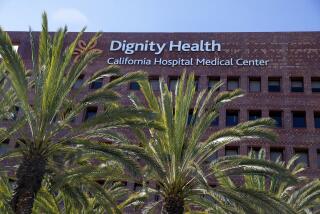Report lists pneumonia death tolls at hospitals
- Share via
The third report since 2004 on how California hospitals treat pneumonia confirmed that where patients go can mean the difference between living and dying.
Patients at the worst- performing hospitals were twice as likely to die as those at the best-ranked hospitals.
Los Angeles County is in better shape than most, with 20 of 92 hospitals surveyed that rated “better than expected” and four that rated “worse than expected.”
The report, released this week by the Office of Statewide Health, Planning and Development, looked at 30-day mortality rates for community- acquired pneumonia between January 2003 and November 2005. “Community-acquired” means that the bacteria, viruses, fungi or other organisms that cause pneumonia were contracted at home or at work as opposed to more deadly, drug-resistant strains acquired in nursing homes, jails and other institutional settings, including hospitals themselves.
The findings
* The statewide mortality rate was 12.2%, or about one of every eight patients admitted with pneumonia. This was virtually unchanged from the earlier reports, which covered 2002-04 and 1999-2001.
* In the newest report, 48 hospitals in the state were rated “better than expected,” with an average death rate of 8.2%, and 47 hospitals rated “worse than expected,” with an average death rate of 16.7%, double that of the better hospitals. More hospitals qualified for both categories than in the two previous reports because the state made a change in its formula for adjusting risk, or accounting for the severity of illnesses by age and other conditions.
* No hospitals went from “better” to “worse,” or vice versa.
* Los Angeles County hospitals rated “better than expected” in all three reports include Cedars-Sinai Medical Center, East Los Angeles Doctor’s Hospital, Garfield Medical Center, Monterey Park Hospital, St. John’s Hospital and Health Center and White Memorial Medical Center.
* No Los Angeles County hospitals rated “worse than expected” in all three reports. In the newest report, Coast Plaza Doctors Hospital, Kaiser Foundation Hospital-Panorama City, Pacifica Hospital of the Valley and Torrance Memorial Medical Center rated “worse than expected.”
The goal
The overall goal of the reports, said Joseph Parker, director of the Healthcare Outcomes Center at the state health planning agency, is to improve the quality of healthcare, especially the treatment of community-acquired pneumonia. Hospitals can use the reports to compare their performance against their peers. Those that perform poorly can adopt national guidelines aimed at boosting performance.
“Whether hospitals are identified as better or poorer in this report, there are a number of national quality improvement efforts that are underway for pneumonia specifically,” Parker said. If hospitals “are not already participating in those, they should do so.”
The reports also are intended to provide hospital transparency and accountability. Consumers who are able to choose their own hospitals can use the reports to compare treatment outcomes. Employers can consult the reports when making decisions about which healthcare plans to offer their employees.
About the report
The report rates hospitals using a formula that adjusts for factors that can increase the risk that a patient will die, such as age, gender, co-existing medical conditions and sample size. A total of 384 hospitals statewide reported discharge data on hospital admissions for community-acquired pneumonia; of these, 30 were excluded because they had too few patients.
Hospitals can contest or explain their data in letters that are included in the report. Dr. Eric Milefchik, Torrance Memorial’s infectious disease committee chairman, said in a prepared statement that his hospital had mistakenly included nursing home and bed-and-board admissions in the data reported to the state. Parker said the hospital had had ample time to note and correct the error. Torrance also ranked worse than expected in the 2002-04 report.
Although the numbers are several years old before the data can be crunched and the report issued, healthcare experts call this type of public reporting one of the most inexpensive and effective incentives for hospitals to improve patient care.
For the full report, go to www.oshpd.ca.gov.
Other sources of information on hospital quality include the U.S. Department of Health and Human Services (www.hospitalcompare.hhs.gov) and the Oakland-based nonprofit California Healthcare Foundation (www.calhospitalcompare.org).
--
More to Read
Sign up for Essential California
The most important California stories and recommendations in your inbox every morning.
You may occasionally receive promotional content from the Los Angeles Times.









